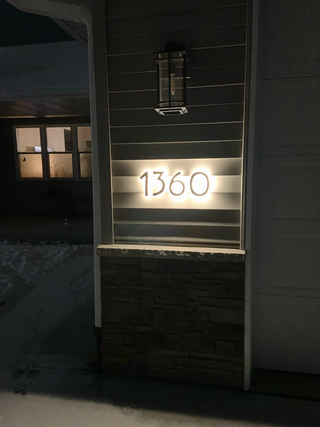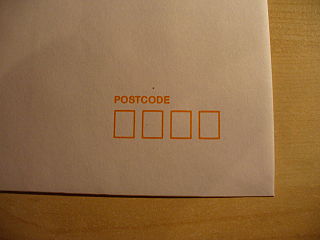
In the administrative divisions of France, the department is one of the three levels of government under the national level, between the administrative regions and the communes. Ninety-six departments are in metropolitan France, with an additional five constituting overseas departments, which are also classified as overseas regions. Departments are further subdivided into 333 arrondissements and 2,054 cantons. These last two levels of government have no political autonomy, instead serving as the administrative basis for the local organisation of police, fire departments as well as, in certain cases, elections.

A postal code is a series of letters or digits or both, sometimes including spaces or punctuation, included in a postal address for the purpose of sorting mail.

A ZIP Code is a system of postal codes used by the United States Postal Service (USPS). The term ZIP was chosen to suggest that the mail travels more efficiently and quickly when senders use the code in the postal address.

Postal codes used in the United Kingdom, British Overseas Territories and Crown dependencies are known as postcodes. They are alphanumeric and were adopted nationally between 11 October 1959 and 1974, having been devised by the General Post Office. A full postcode is known as a "postcode unit" and designates an area with several addresses or a single major delivery point.
ISO 3166-2:FR is the entry for France in ISO 3166-2, part of the ISO 3166 standard published by the International Organization for Standardization (ISO), which defines codes for the names of the principal subdivisions of all countries coded in ISO 3166-1.

A Canadian postal code is a six-character string that forms part of a postal address in Canada. Like British, Irish and Dutch postcodes, Canada's postal codes are alphanumeric. They are in the format A1A 1A1, where A is a letter and 1 is a digit, with a space separating the third and fourth characters. As of October 2019, there were 876,445 postal codes using Forward Sortation Areas from A0A in Newfoundland to Y1A in Yukon.
The INSEE code is a numerical indexing code used by the French National Institute for Statistics and Economic Studies (INSEE) to identify various entities, including communes and départements. They are also used as national identification numbers given to people.
Poste restante, also known as general delivery in North American English, is a service where the post office holds the mail until the recipient calls for it. It is a common destination for mail for people who are visiting a particular location and have no need, or no way, of having mail delivered directly to their place of residence at that time.

An address is a collection of information, presented in a mostly fixed format, used to give the location of a building, apartment, or other structure or a plot of land, generally using political boundaries and street names as references, along with other identifiers such as house or apartment numbers and organization name. Some addresses also contain special codes, such as a postal code, to make identification easier and aid in the routing of mail.
In France, a municipal arrondissement is a subdivision of the commune, and is used in the country's three largest cities: Paris, Lyon and Marseille. It functions as an even lower administrative division, with its own mayor. Although usually referred to simply as "arrondissements", they should not be confused with departmental arrondissements, which are groupings of communes within one département.

Postal codes in the People's Republic of China are postal codes used by China Post for the delivery of letters and goods within mainland China.

Vehicle registration plates are mandatory number plates used to display the registration mark of a vehicle registered in France. They have existed in the country since 1901. It is compulsory for most motor vehicles used on public roads to display them.

La Poste is a postal service company in France, operating in Metropolitan France, the five French overseas departments and regions and the overseas collectivity of Saint Pierre and Miquelon. Under bilateral agreements, La Poste also has responsibility for mail services in Monaco through La Poste Monaco and in Andorra alongside the Spanish company Correos.

Postcodes in Australia are used to more efficiently sort and route mail within the Australian postal system. Postcodes in Australia have four digits and are placed at the end of the Australian address, before the country. Postcodes were introduced in Australia in 1967 by the Postmaster-General's Department and are now managed by Australia Post, Australia's national postal service. Postcodes are published in booklets available from post offices or online from the Australia Post website.

Postal codes in Thailand are five digit numbers. The first two digits of the postal code denote the province or special administrative area, while the last 3 digits represent the post office within the province. There are exceptions, for example, Bangkok and Samut Prakan province shared the first two digits 10xxx. It's typical to use postal code ended with zero 0 because they are assigned to post office that are responsible for delivering mail to the district. For example, mails to Dusit district destinations uses postal code 10300 except within Chitralada Palace where postal code 10303 is used. 10300 is postal code of Dusit Post Office which handles the delivery throughout Dusit district while 10303 is postal code of Chitralada Palace Post Office which does not deliver mails outside the palace. Other post offices in Dusit district exist, such as Bang Krabu Post Office with postal code 10301, the code used for mails to be delivered to P.O. Box in the post office.

In Poland, postal codes were introduced in 1973. They are five-digit codes of two-then-three digits, with a hyphen between them. The first digit indicates one of the 10 large postal regions the country is divided into. These areas do not follow the administrative divisions. The second and third digits specify a particular smaller region, and the last two are the number of a postal delivery branch.
Postcodes in the British Overseas Territory of Bermuda use two different formats, depending on whether they are for street addresses or PO Boxes.
Postal codes used in Saudi Arabia are colloquially known as postcodes.

Postcodes used in Oceania vary between the various sovereign nations, territories, and associated states in the region. Many of the smaller island regions in Oceania use postal code systems that are integrated into the postal systems of larger countries they are territories or associates of.












